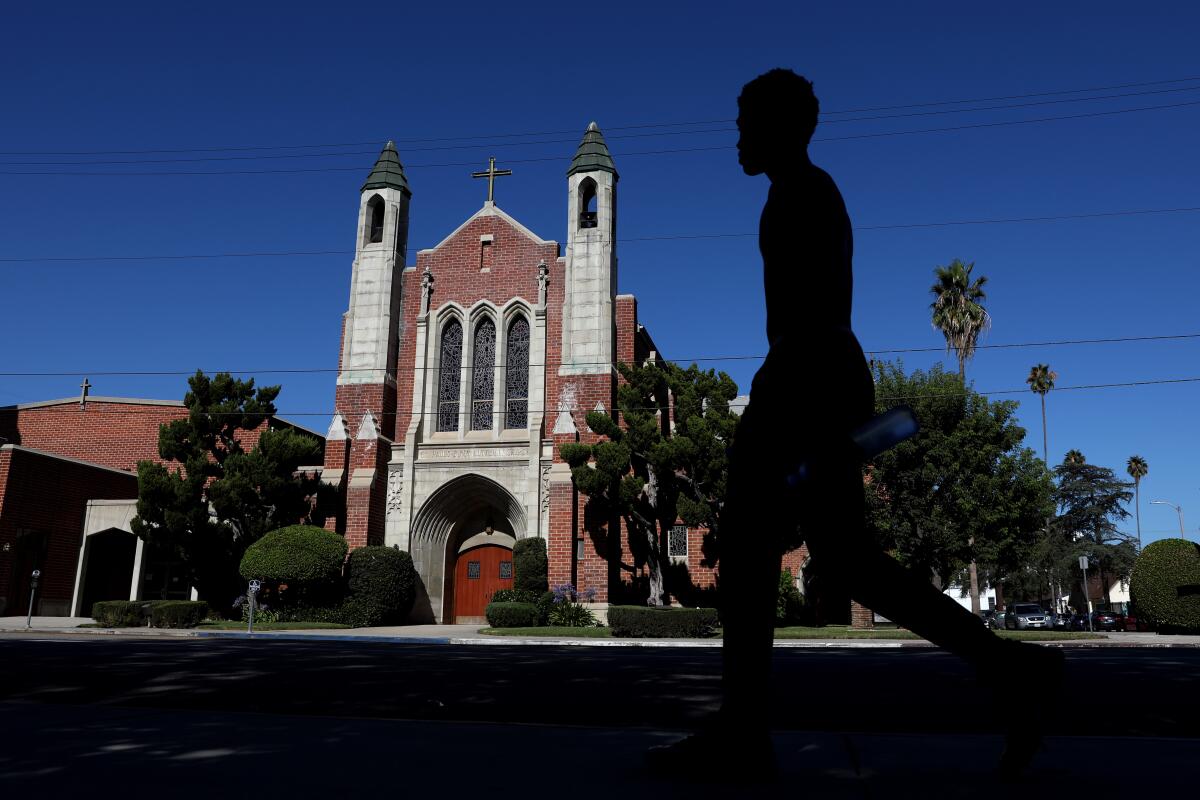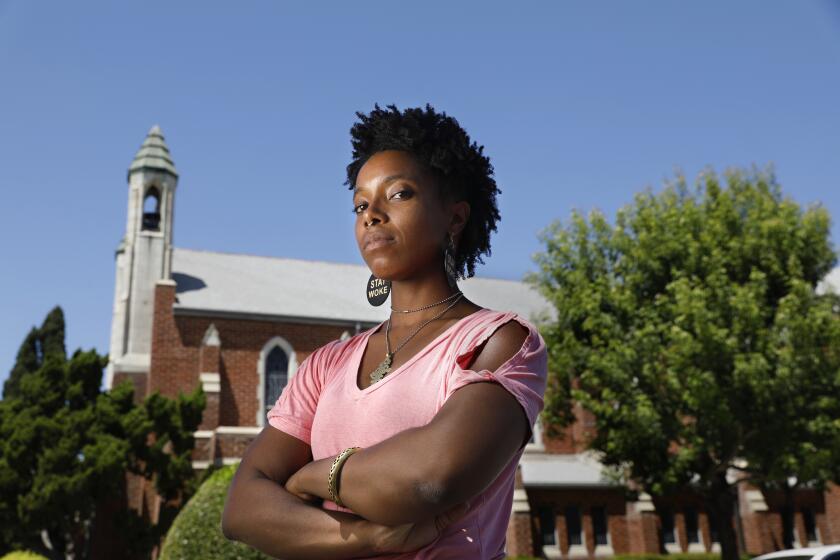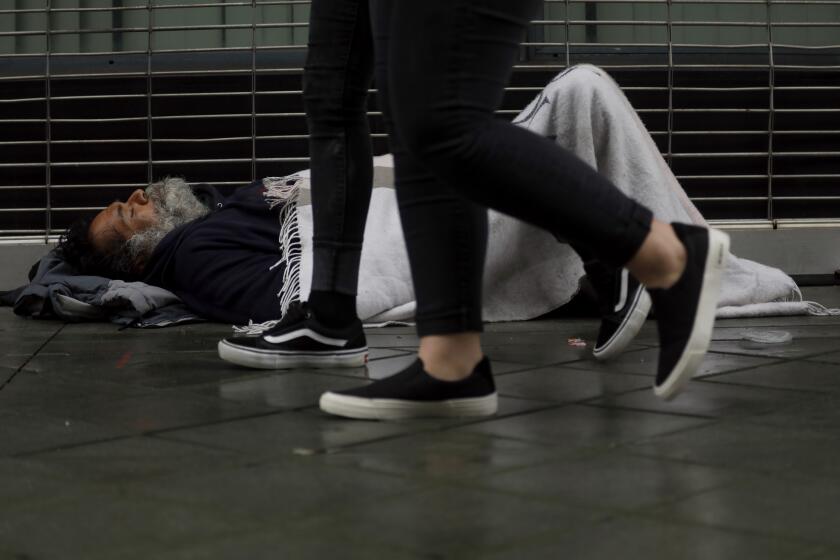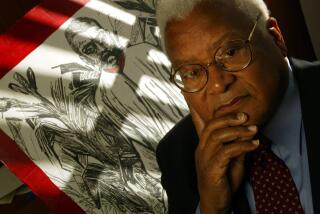An L.A. church seeks healing after a ‘violent and racist’ trauma

- Share via
I went to church on Sunday, to St. Paul’s First Lutheran Church in North Hollywood — though I wasn’t sure if I’d be welcome there, given the strong words I’d just written about the deeply unwelcoming way several of its members had treated a Black woman who had sat down for a rest on the church lawn.
I don’t want to give you the false impression that what I’m about to tell you is all puppies and rainbows — problem raised, problem addressed. From what I can gather, a good part of the congregation still is in stunned disbelief about all the unwanted attention.
But I have to start by saying that I was warmly welcomed at St. Paul’s, as was Alex Marshall-Brown, who just a few days before had used her cellphone to film an older white man in the congregation telling her she was not welcome on the lawn, screwing a “No Trespassing” sign onto the trunk of the tree she’d chosen to sit under for shade and announcing to her, “All lives matter,” apropos of nothing she’d said. All this after she’d broken the ice by speaking to him as he at first went about his business with the sign without saying one word to her.
When Alex Marshall-Brown, a Black actress and stuntwoman, sought shade on the lawn of an L.A. church, she videotaped the way church members let her know they wanted her gone.
Protesters also came to the church Sunday to support Marshall-Brown, holding their own signs, including ones that read “Black Lives Matter” and “This church is racist” and “Love thy neighbor.” Or quoted from the Bible, as in: “Do not mistreat or oppress a foreigner, for you were foreigners in Egypt.”
Younger members of the church family wearing Black Lives Matters T-shirts welcomed the newcomers at a booth on the lawn, offering them free water, doughnuts, fruit and granola bars.
And I found the welcome mat out when I introduced myself to Santiago Botero, the acting principal of the church school, who has been the public voice of St. Paul’s since Marshall-Brown posted her account and recording of the incident on July 7.
By Sunday, my email inbox was full of messages from people who accused Marshall-Brown of staging a conflict and me of finding racist behavior where there was none.
Botero, for the record, immediately told me that I had written the truth. He praised Marshall-Brown, with whom he’d met the day after the incident, and characterized the way church volunteers had treated her as “violent and racist” and “utterly unacceptable,” regardless of whether they understood that at the time or whether that had been their intent.
The three people in her video were church volunteers, he told me. The two men in the video had resigned.
St. Paul’s earlier issued an apology on its Facebook page announcing the resignations and saying the incident “was not handled in a way representative of the church or the school.” It also posted an apology July 10 from the Wisconsin Evangelical Lutheran Synod, the 370,000-member, theologically conservative Lutheran denomination to which the church belongs, calling the church members’ comments to Marshall-Brown “disrespectful and insensitive” and essentially acknowledging a racist tenor.
“It is the position of WELS that racism in any form is not acceptable in the eyes of God or in the ministry of our synod,” the synod’s president, Mark Schroeder, had written.
Marshall-Brown, an actress and stuntwoman, had been on the church lawn only briefly last Tuesday when people started making it clear to her they wanted her gone. First came representatives from the local business improvement district, then someone checking to see that the church doors were locked, then the man with the sign accompanied by another older white man, soon joined by an older white woman from the church preschool across the street.
That woman and the man putting up the sign alluded to problems they’d had in the past with homeless people — without using the word “homeless.”
As they told Marshall-Brown about other people’s bad behavior, she kept politely asking them, to no avail, to tell her in what way she herself was misbehaving.
“Alex felt threatened,” Botero told me Sunday of the incident, which he said should never have been the case. Not at a church. Not at his church. Not by people devoted to God.
And some people within the church, he acknowledged, were now reacting as if they were the threatened ones, as they faced negative publicity, angry emails, comments and phone calls.
Botero told me that the church, with its quiet, formal services based on Scripture as the sole word of God, was not used to this sort of controversy and was struggling with it.
I had noticed that the church had password-protected its previously public website (a move that was recently reversed) and pulled down its Facebook page, containing the apologies. And I knew from personal experience that no one had been answering church phones.
Botero, who is 26 and, as an immigrant from Colombia, acutely sensitive to treatment of strangers, said he’d been trying to encourage others in the church not to take a defensive stand. He said he’d already gotten a commitment from church leaders to implement anti-racist training for church and school staff.
He said the church has had issues with homeless people vandalizing property and sometimes acting in ways that made staff members worry about the safety of kids at the school. But he expressed hope that proper training would make the church community better able to assess those who came to it as individuals, instead of acting on generalized fear.
At last count, more than 36,000 homeless people were living in Los Angeles, nearly 59,000 in the county. But how can we actually help the homeless? What practical aid can we offer?
He confirmed my reporting that many in the church are older, and that some of those older people are uncomfortable with sudden upheaval. Some, he said, were still trying to process outrage they didn’t quite understand.
“This is a church that is traumatized,” he told me. “Their boat took a very narrow curve, and it’s flipping, and they acknowledge that there is water inside of it, but they don’t know what to do with it yet.”
I wasn’t able, though I tried very hard, to get members of the congregation who are still grappling with these issues to talk to me this week.
But the sense I got from those who did speak to me was that, like institutions all over this country right now, the church boat will end up moving forward, pushed by the national current.
Strong voices within the congregation are demanding it.
Bettina Winfrey, a younger church member who with Botero met with Marshall-Brown last week, told me she reached out to women in the congregation on Facebook to join her new anti-racist book club, and seven have signed up so far. She has two young children in the church school and said she is determined that the church not only teach them Christian values but model them.
Outside the church Sunday, I also met Sonya Cole, who has gone to St. Paul’s for nearly 15 years and is one of its few Black members. She was raised Lutheran in Milwaukee, she told me. She loves St. Paul’s and its school, which her grown son attended. She has always felt loved by her church family.
But she was so “livid” and “appalled” by the actions of people she knew in the video — and so hurt that no one in the church immediately reached out to her when she let it be known how upset she was — that at first it made her question whether they truly accepted her as a Black person. She has asked that church leaders let her express her feelings to them.
“There needs to be a dialogue where we all get together and we have a conversation about how we can heal this — and there needs to be an exchange of ideas,” she told me, with Black members’ input valued.
Marshall-Brown also has made it clear that she’s willing to stick around to help. She said as much in a very personal speech she gave after church Sunday in the park across the street, in which she expressed her desire to meet with the three church members who reacted to her out of misguided fear.
“I’d love to connect with them in discussion of our trauma. I think it could heal all of us,” she said, as a crowd, including church members, cheered her on. “I understand if they need some time, but know that I am willing. This is an invitation to rebuild trust.”
Amen.
More to Read
Sign up for Essential California
The most important California stories and recommendations in your inbox every morning.
You may occasionally receive promotional content from the Los Angeles Times.













